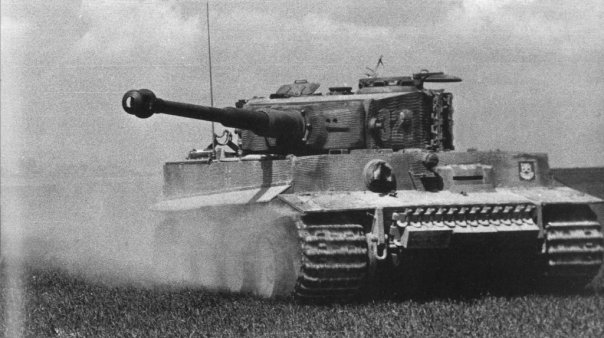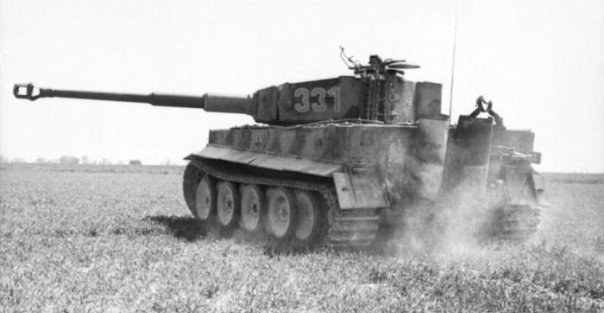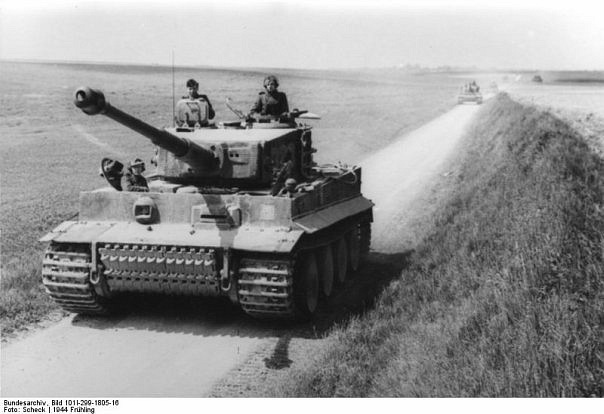The SS main office issued orders for the establishment of a heavy
tank battalion on 24 December 1942 (order: Org.Tgb.Nr. 8990/42 geh.).
The two heavy tank companies ofSSPanzer-Grenadier-Division
"Leibstandarte SS Adolf Hitler" and SS-Panzer-Grenadier-Division "Das
Reich" were to be consolidated with the battalion to form two of its
tank companies. The battalion was to be established at the
Bergen-Fallingbostel Training Area.
Beside these two companies (KSt u. KAN 1176d dated 15 August 1942), the following units were to be formed:
· 1 heavy tank battalion headquarters (KSt u. KAN 1107 dated 1 November 1941)
· 1 heavy tank battalion headquarters company (KSt u. KAN 1150d dated 15 August
1942)
· 1 heavy tank battalion maintenance company (KSt u. KAN 1187b dated 25 April 1942)
The replacement battalion was to be SS-Panzer-Ersatz-Abteilung 1 in Weimar-Buchenwald.
The commander was designated as SS-Hauptsturmfiihrer Laackmann.
24 March 1943: The
SS-Panzer-Korps receives orders from the SS Main Office to dispatch
twenty tank crews to Paderborn (for five additional Tigers for each
heavy SS-PanzerKompanie, three for the battalion headquarters and two
reserve crews).
27 March 1943:
SS-Panzer-Grenadier-Division "Das Reich" and SS-Panzer-GrenadierDivision
"Totenkopf' each send 6 tank crews to Paderborn. The division commander
of SS-Panzer-Grenadier-Division "Leibstandarte SS Adolf Hitler" refuses
to carry out this order, because he prefers to keep his Tiger company.
In response, the SS Main Office directs SS-Panzer-Ersatz-Abteilung 1 to
provide the remaining crews.
April and May 1943:
The SS-Panzer-Korps received fifteen Tiger I tanks earmarked for this
battalion. The tanks were then divided among the three companies. The
original plans to employ this new battalion during Operation "Citadel"
did not' materialize. The three divisions retained their heavy
companies. Later on, only the personnel of the Tiger company of
SS-Panzer-Grenadier-Division "Leibstandarte SS Adolf Hitler" merged into
this newly formed battalion, which was redesignated as schwere
SS-PanzerAbteilung 101.
The battalion was established by order of SS Main Office on 19 July 1943
as a corps formation of the I. SS-Panzer-Korps. Two of the three
companies needed to be established; the third company was formed from
the 13./SS-Panzer-Regiment 1. The maintenance platoon of this company
was merged into the battalion's Maintenance Company.
19 July 1943: Establishment of the battalion starts at the Senne Training Area (South Camp).
5 August 1943: The new
battalion commander, SS-Sturmbannfiihrer von Westernhagen, is still
absent on a training course and recovering from a severe injury.
23-27 August 1943: Relocation to the area of Verona (Italy).

15-25 August 1943: Twenty-seven new Tigers arrive, including two command tanks.
27 August-30 September 1943: Establishment continues in Reggio Nell Emilia.
6 October 1943: Establishment of the 3./schwere SS-Panzer-Abteilung 101 starts.
12 October 1943: Attachment
to SS-Panzer-Grenadier-Division "Leibstandarte SS Adolf Hitler" and
training in the area of Pontecurone (southwest of Voghera) with the
assistance of personnel from SS-Panzer-Regiment 1.
27 October 1943: A detail is sent to Burg (Magdeburg) to pick up ten Tigers.
28 October 1943: The 1.
and 2./schwere SS-Panzer-Abteilung 101 (SS-Hauptsturmfiihrer Kling and
SS-Untersturmfiihrer Wendorff, respectively) are reassigned to the 1.
SSPanzer-Division "Leibstandarte SS Adolf Hitler," where they are
consolidated and redesignated as the 13./SS-Panzer-Regiment 1.
SS-Hauptsturmfiihrer Kling is named the comman der.
der.
2 November 1943: Ten new Tigers that are already moving by rail to the Eastern Front are stopped in Lemberg (Lvov) and redirected to Paderborn.
5-11 November 1943: Movement of the 13./SS-Panzer-Regiment 1 to the Eastern Front, where it is allocated to the 4. Panzer-Armee (27 Tigers).
3-8 November 1943: The
remaining elements-the battalion headquarters, the battalion
headquarters company (SS-Hauptsturmfiihrer Mobius), the 3./schwere
SS-PanzerAbteilung 101 and the battalion maintenance company (minus its
1st Platoon) are transported to the Senne (North) Training Area near Augustdorf. Several Italian wheeled vehicles are now in the battalion's
inventory.
9 November 1943:
SS-Obersturmbannfiihrer Leiner is designated the battalion commander
until SS-Sturmbannfiihrer von Westernhagen can arrive.
SS-Hauptsturmführer Schweimert is given command of the 3./schwere
SS-Panzer-Abteilung 101.
8 November-27 December 1943:
Individual and crew-level training.
SS-PanzerGrenadier-Ausbildungs-Ersatz-Bataillon 1 provides the battalion
with 120 soldiers. The misdirected ten Tigers finally arrive.
27 December 1943: Start
of platoon- and company-level training. Due to the lack of
special-purpose vehicles, full combat readiness cannot be established.
1 January 1944: The
battalion's strength reaches only eighteen officers / eighty-three
noncommissioned officers / / 365 enliste~ personnel (full strength is
twenty-seven officers /153 noncommissioned officers /419 enlisted
personnel). Operational tanks: 9.
3 January 1944: A detail is sent to Burg to pick up another ten Tigers (of which two are command tanks).
9 January 1944: The
detail arrives in Mons (Belgium). Due to a damaged railway car, one
Tiger has to be left behind near the Belgium border and arrives several
days later.
9-12 January 1944: Relocation to the Maisieres Training Area near Mons.
13 January 1944: Training is continued. The 3./schwere SS-Panzer-Abteilung 101 now has eighteen tanks (four platoons of four tanks each).
12 February 1944: Field-training exercise of the 3./schwere SS-Panzer-Abteilung 101, which is attended by SS-Obergruppenfiihrer Dietrich.
13 February 1944: Arrival of SS-Sturmbannfiihrer von Westernhagen.
20 March 1944: The crews
of the 13./SS-Panzer-Regiment 1 return from the Eastern Front and join
the battalion. Continuation of training and refitting. The
13./SS-PanzerRegiment is consolidated with the battalion and forms two
companies: 1./schwere SS-Panzer-Abteilung 101 (SS-Hauptsturmführer
Möbius) and the 2./schwere SS-Panzer Abteilung 101 (SS-Obersturmführer
Wittmann). The 3./schwere SS-Panzer-Abteilung 101company transfers its
4th Platoon to the 1./schwere SS-Panzer-Abteilung 101 (as its 3rd
Platoon) .
3-4 April 1944: Relocation into the area of Gournay-en-Bray-Beauvais in expectation of an Allied invasion in the area of the Pas de Calais.
20 April 1944: Eighteen of twenty Tigers operational. Delivery of the rest of the vehicle inventory and twenty-five Tiger I tanks.
22 April 1944: Last eleme nts of the 13./SS-Panzer-Regiment 1 that remained in Russia return to the battalion.
nts of the 13./SS-Panzer-Regiment 1 that remained in Russia return to the battalion.
30 April 1944: Thirty-eight of forty-five Tigers operational.
10-17 May 1944: Live-fire
exercise of the entire battalion east of Amiens. Redeployment to the
former assembly area and continuation of the training.
1 June 1944: Operational tanks: 37.
7 June 1944: March on the
D 316 to the road junction of St. Jean de Fronelles (via
Gournay-en-Bray and Morgny. At Morgny, the 1./schwere
SS-Panzer-Abteilung 101 is strafed by fighter-bombers. The march
continues on the N 14 to Paris, passing the Arc de Triomphe to
Versailles. The 2./schwere SS-Panzer-Abteilung 101 and the Maintenance
Company are hit by a air strike near Versailles.
8 June 1944: The 1. and
2./schwere SS-Panzer-Abteilung 101 continue to road march via
Verneul-l'Aigle. From there the 1./schwere SS-Panzer-Abteilung 101
proceeds via Vimoutiers to the area south of Caen. The 2./schwere
SS-Panzer-Abteilung 101 moves via Argentan to Falaise. The 3./schwere
SS-Panzer-Abteilung 101 returns to Paris and starts single tank movement
to the west on the next day. Numerous strafing attacks by
fighterbombers.
9 June 1944: During the next few days, road marches are conducted only during the night due to the Allied air threat.
10 June 1944: The
2./schwere SS-Panzer-Abteilung 101 is strafed by fighters in Argentan. A
short while later it is hit from the air again at Occagnes. 1 aircraft
is shot down by SS-Unterscharführer Warmbrunn with antiaircraft
machine-gun fire. The 2./schwere SS Panzer-Abteilung 101 arrives in
Falaise during the night.
12 June 1944:
During the night, the battalion completes arrival in its designated
assembly area, experiencing many mechanical problems and failures during
the road march. The 1./schwere SS-Panzer-Abteilung 101 (eight Tigers)
assembles eight kilometers northeast of Villers-Bocage on the N 175; the
2./schwere SS-Panzer-Abteilung 101 (six Tigers) assembles in a defile
south of Montbrocq (two kilometers northeast of Villers-Bocage).The
b attalion is immediately ordered to cover the left flank of the I.
SS-Panzer-Korps. Because of incessant heavy naval shelling, the crews
cannot rest.
attalion is immediately ordered to cover the left flank of the I.
SS-Panzer-Korps. Because of incessant heavy naval shelling, the crews
cannot rest.
13 June 1944: In the
morning, the 2./schwere SS-Panzer-Abteilung 101 (six Tigers; Lotzsch's
Tiger has track damage) is assembled at Point 213 northeast
of Villers-Bocage in a defile south of the road Villers-Bocage-Caen. A
detachment of the British 22nd Armoured Brigade approaches Point 213 and
stops there. The British element is moving in column along the road and
not deployed for combat. This element was attempting to exploit a gap
between the 352. Infanterie-Division and the Panzer-Lehr-Division.
SS-Obersturmführer
Wittmann attacks the enemy - a Squadron of the 4th City of London
Yeomanry and parts of the 1st Battalion of the Rifle Brigade-ahead of
his company, which is not yet ready for action. He uses Tiger 222 of
SS-Unterscharfiihrer Sowa. First, he knocks out a Cromwell and a Firefly
of A Squadron, which had already nearly reached Point 213. Afterwards,
he advances parallel to the road towards Villers-Bocage. Passing within
a short distance of the enemy, he destroys the majority of the 1st
Rifle Brigade: thirteen M-3 halftracks, three Stuart light tanks, two
Sherman artillery observer tanks, the Daimler Scout Car of the brigade's
Intelligence Officer, the M-3 of the brigade surgeon, and more than one
dozen Bren and Lloyd carriers (some from the antitank-gun battery). At
the outskirts of the town, he knocks out three of the four Cromwells of
the regimental headquarters section of the City of London Yeomanry.
Still alone, he enters Villers Bocage, pursued by the fourth Cromwell,
which intends to hit the Tiger from the rear. Inside the town,
Wittmann's forward progress is stopped by tanks of B Squadron (including
one Sherman Firefly). He turns around and rushes back along his route
of advance. On his way back, he knocks out the Cromwell, whose two
armor-piercing rounds fired at a distance of only fifty meters fail to
penetrate the Tiger. After several hundred meters, the
tank becomes immobilized from an antitank gun hit damaging the left front drive
sprocket.
The crew bails out and leaves the tank. It sneaks through to the
command post of the Panzer-Lehr-Division at Orbois-Sermentot, which
directs offensive action towards Villers-Bocage with fifteen Panzer IVs.
The remaining tanks of the 2./schwere SS-Panzer-Abteilung 101 occupy
position east ofVillers-Bocage (south of the road) and knock out two
more Cromwells (SS-Unterscharfiihrer Sowa) and three Shermans
(SS-Oberscharführer Brandt). Approximately 230 British soldiers
surrender and are taken prisoner. Eight Tigers of the 1./schwere
SS Panzer-Abteilung 101 (SS-Hauptsturmführer Möbius) attack at 0800 hours
along the N 175 towards Villers-Bocage. Five Cromwells positioned
farther north are damaged and abandoned by the crews. Several Panzer IVs
of the Panzer-Lehr-Division positioned at Parfouru-sur-Odon join the
attack. Two Tigers and one Panzer IV advance along the main road (Rue
Pasteur). The rear tank-Tiger 112 of SS-Oberscharfiihrer Ernst is
knocked out by a Firefly of B Squadron, which fires through two corner
windows of a building. After changing positions, a Panzer IV is knocked
out by an antitank gun. The leading tank-Tiger 121 of SS Obersturmführer
Lukasius is hit from the rear by a Firefly. These tanks are then set on
fire by the British. Five more Tigers advance forward on roads farther
south. One Tiger is knocked out by an antitank gun in the Rue Emile
Samson. Two more Tigers are immobilized by antitank-gun fire. Tiger 132
of SS-Unterscharführer Wendt remained at the outskirts of the village.
During the night, Tiger 132 is in position on Hill 213. Four Tigers of
the 1./schwere SS-Panzer-Abteilung 101 are positioned south
ofVillers-Bocage; the 2./schwere SS-PanzerAbteilung 101 assembles again
in the defile parallel to the N 175. The 3./schwere SS-Panzer-Abteilung
101 reaches Falaise. The casualties of the battalion on this day amount
to three tank commanders and seven other crew members. Three Tigers of
the 1./schwere SS-Panzer-Abteilung 101 are lost, whereas the British
lose twenty six tanks, fourteen M-3s, eight Bren Carriers, and eight
Lloyd Carriers.
Total tanks: 42.
For his decisive influence on the course of the day's events, SS-Obersturmführer Wittmann is recommended for the Swords to the Knight's Cross.
14 June 1944: In an
assault into  the area of Villers-Bocage-Cahagne, the 1./schwere
SS Panzer-Abteilung 101 is tied down by concentrated enemy artillery
fire.
the area of Villers-Bocage-Cahagne, the 1./schwere
SS Panzer-Abteilung 101 is tied down by concentrated enemy artillery
fire.
15 June 1944: The
3./schwere SS-Panzer-Abteilung 101 moves into the assembly area near
Evrecy. During the night, the 3./schwere SS-Panzer-Abteilung 101 (four
Tigers) is hit by a heavy air strike. Almost all the Tigers are
inoperative. The tank of SS-Untersturmfuhrer Gunther and another one
burn out completely; another one attempting to evade the air attack
tumbles into a defile, killing the crew. The turret of the company
commander's tank is blown off. Altogether, there are eighteen dead and
eleven wounded soldiers; among the civil population, 138 persons are
killed.
Total tanks: 38.
In the morning, the 1./schwere
SS-Panzer-Abteilung 101 launch an attack with four Tigers (including
Wendt's tank) right into British forces attempting to escape. Five enemy
tanks are destroyed, as is Wendt's tank, whose crew bails out.
Total tanks: 37.
16 June 1944:
Four Tigers of the 1./schwere SS-Panzer-Abteilung 101 start a
counterattack near Cahagnes; the leading tank-Tiger III of
(SS-Obersturmfuhrer Philipsen) is set on fire by an antitank gun. Mter
bailing out, the platoon leader is killed.
Total tanks: 36.
18 June 1944: The battalion is kept in reserve on both sides of the road Caen-Villers Bocage; urgent needed maintenance is performed.
21 June 1944: The battalion commander is promoted to SS-Obersturmbannführer.
22 June 1944: SS-Obersturmfuhrer
Wittmann is awarded the Swords to the Knight's Cross and promoted to
SS-Hauptsturmfuhrer. (The award is presented on 29 June 1944 at
Berchtesgaden) .
23 June 1944:
Several tanks of the 3./schwere SS-Panzer-Abteilung 101 under
SS Untersturmführer Amselgruber are positioned along the Route Nationale
and repulse the British advance. They knock out five enemy tanks.
24 June 1944: Tiger 332 of SS-Unterscharfiihrer Wanecke knocks out seven enemy tanks. Two tanks cannot be repaired.
Total tanks: 34.
26 June 1944: The
3./schwere SS-Panzer-Abteilung 101 parries the British thrust at the
forest near Tessel and near Rauray ( Operation "Epsom").
SS-Untersturmführer Amselgruber with another Tiger of the 3./schwere
SS-PanzerAbteilung 101 knocks out three enemy tanks near Grainville and
stops the advance of the British infantry. Near Mouen, a single Tiger
knocks out several enemy tanks of the 23rd Hussars. New positions are
taken along the line Marcelet-high ground southeast of
CheuxRauray-Vendes. Eighteen Tigers operational.
27 June 1944: On a
reconnaissance mission, the tank of SS-Unterscharführer Warmbrunn is
knocked out by an enemy antitank gun. The eighteen operational tanks of
the battalion are scattered along the corps frontline.
Total tanks: 33.
28 June 1944: In the eventually futile attempt to repulse the enemy assault at
Grainville,
the tank of SS-Untersturmführer Amselgruber (Tiger 331) is finally
knocked out after eliminating two Shermans on this day. The commander,
in spite of a severe leg wound, stays with his men. SS-Hauptsturmführer
Mobius knocks out six enemy tanks and is then knocked out himself. The
remaining Tigers block further enemy advances at Verson and on Hill 112.
In Rauray, one Tiger is knocked out.
Total tanks: 30.
29 June 1944: In the afternoon; a counterattack is conducted in the area of Hill 112.
30 June 1944: Hill 112, temporarily lost to the enemy, is recaptured.



